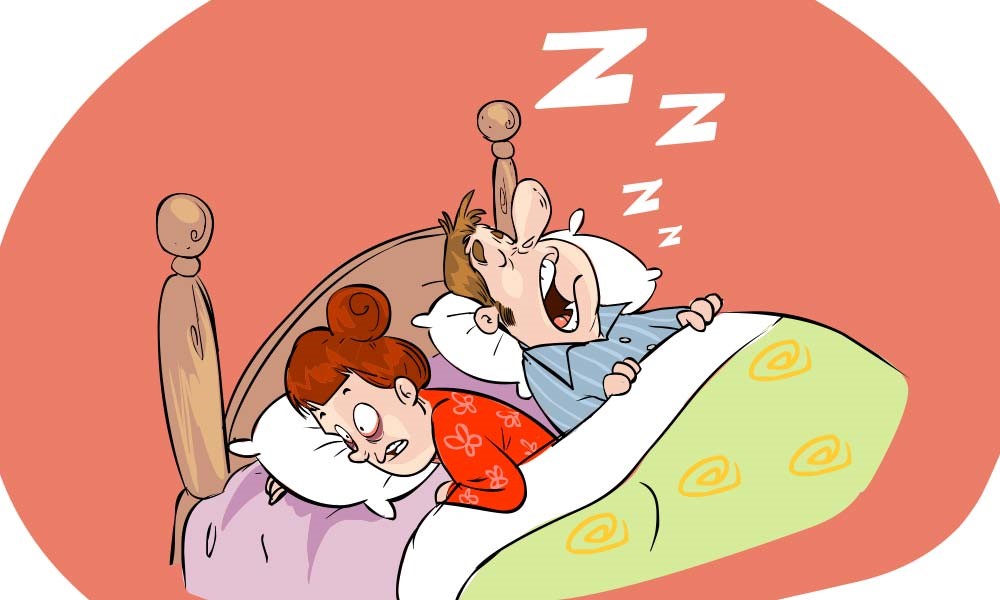 When someone pretends to be asleep, the first thing they do is make a snoring noise. For some reason, the snoring sound is associated with deep sleep. This could not be further from the truth! When we hear someone snoring, we all laugh and think that it’s funny – but it’s NO laughing matter! Although snoring doesn’t mean you have sleep apnea, a very serious sleep-related breathing disorder, it could be a sign of things to come and should not be overlooked. It can affect the quality of life of family and friends whose sleep is interrupted by the loud noises from that snoring. Not a good way to be the favorite uncle!
When someone pretends to be asleep, the first thing they do is make a snoring noise. For some reason, the snoring sound is associated with deep sleep. This could not be further from the truth! When we hear someone snoring, we all laugh and think that it’s funny – but it’s NO laughing matter! Although snoring doesn’t mean you have sleep apnea, a very serious sleep-related breathing disorder, it could be a sign of things to come and should not be overlooked. It can affect the quality of life of family and friends whose sleep is interrupted by the loud noises from that snoring. Not a good way to be the favorite uncle!
The obesity epidemic is on the rise in our country and so, too, is the number of people with sleep-related breathing disorders. Approximately 1 in 4 adults in the United States have Obstructive Sleep Apnea (OSA) and, of those, 85% of patients with treatable OSA are undiagnosed. Let that sink in for a minute… think of all the people you know or hear about that use CPAP machines or have “snoreguards” from their doctor. Of all those people, there are 5x as many that don’t even know they have an issue. For clarification, this is not just related to obesity! Sleep-related breathing disorders affect people of all shapes, sizes, backgrounds, genders, ages, and ethnicities. Obesity is only one of the risk factors.
Snoring may be the first clue that something is wrong. The snoring sound happens when air passes by floppy tissue in the airway and it vibrates. Sometimes snoring is the result of how you are positioned when you sleep, like on your back or stomach, or maybe from too much alcohol consumption which relaxes these tissues. Many times it is the result of a much more complex set of anatomical and physiological factors that lead to airway collapse. This latter scenario is very serious and sets off a chain reaction of bodily compensations. Your body NEEDS oxygen to live and function properly. Any reduction in oxygen can have a lasting impact on your body’s wellness. You are generally hard-wired to take in oxygen. Your cardiovascular system will work extra hard to pump oxygen-carrying blood around to your vital organs when it senses a drop in oxygen levels. The muscles that control your breathing will also overcompensate by rapidly expanding and contracting. When your airway is partially or fully obstructed by floppy tissue, it works extra hard without the desired result, because the oxygen just isn’t getting in. A person having an apneic event (blocked airway) during sleep will actually stop breathing for more than 10 seconds at a time, their body will go into panic mode, eventually they arouse from sleep just enough to gasp some air, and things return to “normal”… until it happens again. How often it happens determines the level of OSA severity. These arousals from sleep, although not usually remembered by the individual, are what cause sleep fragmentation and have the longterm negative health effect. The strain on the cardiovascular system during the apneic event also has a lasting negative health consequence. It is one explanation for why people die in their sleep, a time when we are not seemingly overexerted. As mentioned in the previous SLEEP blog, sleep interruption often leads to hypertension, diabetes, cognitive deficits, neurobehavioral issues (ADHD, anxiety, depression), and GI issues (GERD).
So, what to do, what to do?
At Dental Associates of Walpole, we are concerned for our patient’s overall health. We’ve been screening patients with sleep-related questionnaires recommended by the American Academy of Sleep Medicine and the American Academy of Dental Sleep Medicine in order to find high risk patients. Obstructive Sleep Apnea is a medical issue that must be diagnosed by a physician via a sleep test that measures important vital signs during sleep. Generally, moderate to severe OSA is treated with a CPAP machine. Mild OSA and primary snoring (no apneas) are usually treated with mandibular advancement appliances. Depending on the results and severity, dentists are an important part of the treatment team since we spend all our time at the open end of the airway and are responsible for fabrication of oral sleep appliances. OSA can be very medically complex and have many components that need to be addressed for optimal treatment outcome. We offer a home sleep test which can get the “ball rolling” so to speak and can help to accurately screen for OSA. It may be necessary to have an in-lab polysomnogram (sleep test) with your physician depending on comorbidities (medical issues related to OSA), since the polysomnogram records more vital signs and provides the physician with more detailed information.
It all starts with a conversation! So, if you or someone close to you is snoring, it’s time to get it checked out. Not only to improve your quality of life by getting a better night sleep, but to potentially save a life when that snoring turns out to be a sign of a bigger problem.
Ask a member of our dental team about getting screened. Let’s all sleep better!
By Dr. D’Aprile



